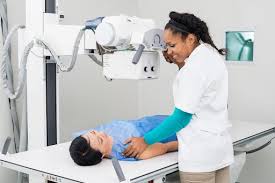
The Essential Role of a Radiology Technologist in Modern Healthcare
The Role of a Radiology Technologist in Healthcare
Radiology technologists play a crucial role in the field of healthcare, utilizing advanced imaging technology to help diagnose and treat various medical conditions. These highly skilled professionals are trained to operate complex equipment such as X-ray machines, CT scanners, MRI machines, and ultrasound devices.
One of the primary responsibilities of a radiology technologist is to perform imaging procedures on patients as requested by physicians. By following precise instructions and protocols, they capture high-quality images that assist doctors in making accurate diagnoses. These images provide valuable insights into the internal structures of the body, helping healthcare providers identify injuries, diseases, or abnormalities.
In addition to operating imaging equipment, radiology technologists are also responsible for ensuring patient safety during procedures. They must carefully position patients to obtain the best possible images while minimizing radiation exposure. Attention to detail and adherence to safety protocols are essential aspects of their work.
Furthermore, radiology technologists often work closely with radiologists and other healthcare professionals to analyze images and provide initial interpretations. Their expertise in imaging techniques allows them to assist in identifying potential issues or anomalies that may require further evaluation.
Continuous education and training are vital for radiology technologists to stay updated on advances in technology and best practices in the field. Many professionals pursue certifications or specialized training programs to enhance their skills and knowledge.
In conclusion, radiology technologists play a critical role in modern healthcare by performing diagnostic imaging procedures that aid in patient care. Their technical expertise, attention to detail, and commitment to patient safety contribute significantly to the overall quality of healthcare services.
Key Benefits of a Career as a Radiology Technologist: Vital, Advanced, Collaborative, and In-Demand
- 1. Essential role in diagnosing medical conditions
- 2. Utilize advanced imaging technology for accurate results
- 3. Work closely with healthcare professionals to provide insights into patient care
- 4. Ensure patient safety during imaging procedures
- 5. Opportunities for specialization and career advancement
- 6. High demand for skilled radiology technologists in the healthcare industry
Challenges Faced by Radiology Technologists: Radiation Exposure, Physical Demands, and High Stress Levels
1. Essential role in diagnosing medical conditions
Radiology technologists play an essential role in diagnosing medical conditions by utilizing their expertise in operating advanced imaging equipment to capture detailed images of the body’s internal structures. These images are instrumental in helping healthcare providers accurately identify and assess a wide range of medical conditions, from fractures and tumors to internal injuries and abnormalities. By producing high-quality diagnostic images, radiology technologists enable physicians to make informed decisions about patient care, leading to timely and effective treatment interventions. Their pivotal role in the diagnostic process highlights the invaluable contribution that radiology technologists make to the field of healthcare.
2. Utilize advanced imaging technology for accurate results
Radiology technologists excel in utilizing advanced imaging technology to ensure accurate and precise results. By operating sophisticated equipment such as X-ray machines, CT scanners, MRI machines, and ultrasound devices, they can capture detailed images that provide valuable insights into a patient’s condition. Their expertise in optimizing imaging settings and following strict protocols allows them to produce high-quality images that are essential for accurate diagnoses and effective treatment planning. The ability of radiology technologists to harness cutting-edge technology ensures that healthcare providers have the information they need to deliver the best possible care to their patients.
3. Work closely with healthcare professionals to provide insights into patient care
Radiology technologists excel in their role by working closely with healthcare professionals to provide valuable insights into patient care. By collaborating with radiologists, physicians, and other medical staff, they contribute their expertise in imaging techniques to help diagnose and treat patients effectively. Their ability to analyze and interpret images plays a crucial role in the decision-making process, ensuring that patients receive the best possible care based on accurate diagnostic information. This collaborative approach underscores the importance of radiology technologists in enhancing the overall quality of patient care within the healthcare system.
4. Ensure patient safety during imaging procedures
Radiology technologists excel in ensuring patient safety during imaging procedures by meticulously following safety protocols and guidelines. Their expertise in positioning patients correctly and adjusting equipment settings help minimize radiation exposure while capturing high-quality images. By prioritizing patient safety, radiology technologists play a vital role in providing a secure and comfortable environment for individuals undergoing diagnostic imaging tests. Their commitment to maintaining the well-being of patients underscores their dedication to delivering quality healthcare services.
5. Opportunities for specialization and career advancement
Radiology technologists have abundant opportunities for specialization and career advancement within the field of healthcare. With various imaging modalities such as MRI, CT scans, mammography, and nuclear medicine, technologists can choose to specialize in a specific area of radiology that aligns with their interests and career goals. By pursuing advanced certifications and training programs, radiology technologists can enhance their skills and expand their job prospects. This flexibility allows professionals in this field to continually grow and evolve in their careers, opening up avenues for higher-level positions and leadership roles.
6. High demand for skilled radiology technologists in the healthcare industry
The healthcare industry has a high demand for skilled radiology technologists due to their specialized expertise in performing diagnostic imaging procedures. As medical facilities continue to expand and technology advances, the need for qualified professionals who can operate imaging equipment and produce accurate results is on the rise. Radiology technologists play a crucial role in helping physicians diagnose and treat various medical conditions, making them essential members of the healthcare team. Their unique skill set and ability to provide high-quality imaging services contribute to meeting the increasing demand for diagnostic imaging services in hospitals, clinics, and other healthcare settings.
Potential exposure to radiation
Radiology technologists face a significant con in their profession: potential exposure to radiation. Operating imaging equipment regularly puts them at risk of long-term health consequences due to prolonged exposure to radiation. Despite stringent safety measures and protocols in place, the cumulative effects of radiation exposure over time pose a serious concern for radiology technologists. It is crucial for these healthcare professionals to prioritize their safety by adhering strictly to safety guidelines, utilizing protective gear, and undergoing regular health screenings to monitor any potential risks associated with their occupational exposure to radiation.
Physically demanding work
The physically demanding nature of the job is a significant con for radiology technologists. The role frequently requires them to stand for extended periods while operating imaging equipment and assisting patients during procedures. Additionally, they may need to support individuals with mobility issues, which can lead to physical strain and discomfort. The demanding physical aspects of the job can take a toll on the health and well-being of radiology technologists, emphasizing the importance of proper ergonomics and self-care practices in this profession.
High stress levels
The high stress levels experienced by radiology technologists can be attributed to various factors within the profession. From handling critically ill patients to conducting time-sensitive procedures, the pressure to maintain accuracy in imaging adds an additional layer of stress. The demanding nature of the job, coupled with the need for precision and quick decision-making, can create a challenging environment for radiology technologists. Managing these stressors is crucial to ensure optimal performance and quality patient care within the field of diagnostic imaging.



